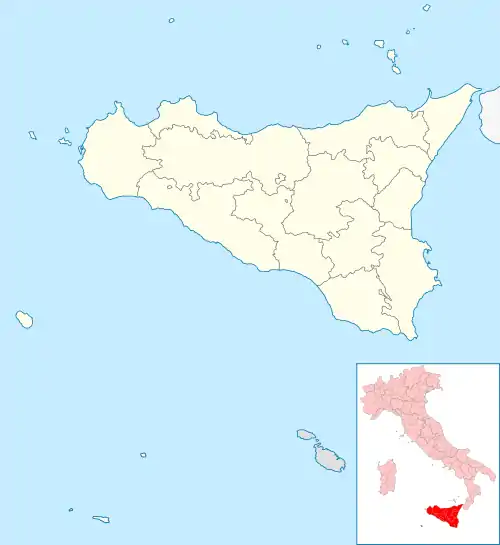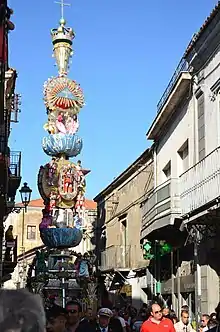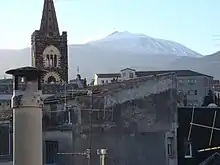Randazzo | |
|---|---|
| Comune di Randazzo | |
.jpg.webp) Randazzo. | |
 Coat of arms | |
Location of Randazzo | |
 Randazzo Location of Randazzo in Italy  Randazzo Randazzo (Sicily) | |
| Coordinates: 37°53′N 14°57′E / 37.883°N 14.950°E | |
| Country | Italy |
| Region | Sicily |
| Metropolitan city | Catania (CT) |
| Frazioni | Flascio, Monte la Guardia, Murazzorotto |
| Government | |
| • Mayor | Francesco Giovanni Emanuele Sgroi |
| Area | |
| • Total | 205.62 km2 (79.39 sq mi) |
| Elevation | 765 m (2,510 ft) |
| Population (31 December 2015)[2] | |
| • Total | 10,900 |
| Demonym | Randazzesi |
| Time zone | UTC+1 (CET) |
| • Summer (DST) | UTC+2 (CEST) |
| Postal code | 95036 |
| Dialing code | 095 |
| Patron saint | St. Joseph |
| Saint day | March 19 |
| Website | Official website |

Randazzo (Sicilian: Rannazzu) is a town and comune in the Metropolitan City of Catania, Sicily, southern Italy. It is situated at the northern foot of Mount Etna, c. 70 kilometres (43 mi) northwest of Catania. It is the nearest town to the summit of Etna, and is one of the points from which the ascent may be made.

Etymology
The name "Randazzo" is believed to have originated from the Arabic term "Randalūs," which means "fortified place" or "stronghold." This name reflects the strategic location and historical significance of the town as a fortified settlement.
During the Arab Emirate of Sicily, which lasted from the 9th to the 11th century, many place names in Sicily were influenced by the Arabic language. Randazzo, like several other towns in the region, acquired its name during this period.
Over time, the Arabic term "Randalūs" transformed into the current name "Randazzo" as the town came under Norman, Angevin, and subsequent dominations. The etymology of place names can evolve and change throughout history, influenced by linguistic shifts, cultural assimilation, and the passage of time.
It's worth noting that the specific etymology of place names can sometimes be subject to debate and interpretation, and alternative theories may exist. However, the Arabic origin of the name Randazzo is widely accepted by scholars and historians.
History
Randazzo is a town located in the province of Catania, in northeastern Sicily, Italy. The history of Randazzo is intertwined with the broader historical developments of the region and the island of Sicily.
The origins of Randazzo can be traced back to ancient times, with evidence of human settlements in the area dating back to the prehistoric period. The town's strategic location in the Etna region made it an important center for trade and agriculture throughout history.
During the Roman period, Randazzo was part of the Roman Empire and served as a hub for agricultural production, especially wine and grain. The Romans developed the infrastructure and agricultural practices in the region, contributing to its prosperity.
In the medieval era, Randazzo came under the rule of various powers, including the Byzantine Empire, the Arab Emirate of Sicily, and the Norman Kingdom of Sicily. The Arabs, who arrived in the 9th century, left a significant cultural and architectural impact on the region.
The town experienced a period of growth and prosperity during the Norman period. The Normans, led by Roger I, conquered Sicily and established the Kingdom of Sicily in the 12th century. Randazzo served as a royal residence and a center of governance under Norman rule. The Normans also promoted the development of agriculture and introduced new agricultural techniques, leading to the expansion of vineyards and orchards in the area.
Throughout the medieval and Renaissance periods, Randazzo was influenced by the rule of various powers, including the Angevins, the Aragonese, and the Bourbons. Each dominion left its mark on the town's architecture, culture, and traditions.
In more recent history, Randazzo, like other parts of Sicily, faced economic and social challenges. Emigration from rural areas to urban centers and other countries led to a decline in population and economic activity in some areas.
Today, Randazzo is known for its well-preserved medieval architecture, including its imposing Norman castle, churches, and historic center. It also serves as a gateway to the natural beauty of Mount Etna, the active volcano that dominates the landscape.
The history of Randazzo reflects the complex historical layers of Sicily, with influences from ancient civilizations, Arab and Norman invasions, and subsequent ruling powers. It stands as a testament to the island's rich cultural heritage and the resilience of its people.
Geography
Randazzo is a town located in the province of Catania, in northeastern Sicily, Italy. It is situated on the northern slopes of Mount Etna, the largest active volcano in Europe. The geography of Randazzo is characterized by its proximity to Mount Etna and the surrounding volcanic landscape.
The town is nestled in a valley surrounded by the natural beauty of the Nebrodi and Peloritani mountain ranges. The Nebrodi Mountains extend to the west of Randazzo, while the Peloritani Mountains lie to the northeast. These mountainous areas provide a picturesque backdrop to the town and offer opportunities for outdoor activities such as hiking and exploring nature trails.
Mount Etna, with its distinctive conical shape, dominates the landscape of Randazzo. The volcano's slopes are covered with lush vegetation, including vineyards and orchards. The fertile volcanic soil supports agricultural activities, and the region is known for its production of grapes, citrus fruits, and olives.
The geographical position of Randazzo also contributes to its climate. The town experiences a Mediterranean climate, characterized by hot, dry summers and mild, rainy winters. However, due to its proximity to Mount Etna, microclimates can be observed, with variations in temperature and precipitation depending on altitude and local conditions.
The territory around Randazzo is also dotted with lava flows and volcanic rock formations, showcasing the geological legacy of Mount Etna's volcanic activity. These features, along with the surrounding natural landscapes, make Randazzo an attractive destination for visitors interested in nature, geology, and outdoor exploration.
Overall, the geography of Randazzo is defined by its location in the foothills of Mount Etna and its proximity to the Nebrodi and Peloritani mountain ranges. The interplay of volcanic features, fertile soils, and scenic mountains contributes to the town's unique setting and natural beauty.
Main sights
- Santa Maria Assunta: church has a façade completely built of black lava stone, three polygonal apses in the form of towers and 15th-century side portals in the Catalan-Gothic style. The huge interior is divided into three naves by black monolithic columns, and preserves statues by the Gagini school and six paintings by Giuseppe Velasquez (1750–1827).

- San Martino: church has a 14th-century bell tower, by some acclaimed as the most beautiful in Italy.
- San Nicola di Bari church, the largest in the town, originally established in the 14th century but rebuilt in 1585. It houses works by Giacomo and Antonello Gagini, and in the right nave a triptych by Messinese painters
- Castello Svevo ("Hohenstaufen Castle"), the only one remaining of the eight medieval towers, on a high lava rock, already existing at the time of Frederick II of Hohenstaufen. For a time it was the seat of the Giustiziere del Valdemone (a kind of medieval judge and governor) and a prison, then became the mansion of the Romeo e Vagliasindi families, to become again a prison in later centuries: a sinister building, with tiny cells, a torture chamber, the wall for those who were sentenced to be bricked up alive. After a recent restoration the castle is used today as an exhibition center and houses a collection of "Pupi siciliani" and the Paolo Vagliasindi archeological museum.

- Aragonese Gate
- Palazzo Lanza
- Palazzo Scala, a former Royal residence from the 12th century.
- Palazzo Finocchiaro (1509)
People
- Domenico Spadafora (1450 - 1521), a Roman Catholic priest, professed member of the Order of Preachers beatified by Pope Benedict XV in 1921.
Transportation
Randazzo is served by two stations: one of the Ferrovia Circumetnea, connecting to Giarre and Catania; one on main Trenitalia station, once connecting it to Taormina and Messina, currently inactive.
Twin towns
 Monte Cerignone, Italy
Monte Cerignone, Italy
References
- ↑ "Superficie di Comuni Province e Regioni italiane al 9 ottobre 2011". Italian National Institute of Statistics. Retrieved 16 March 2019.
- ↑ "Popolazione Residente al 1° Gennaio 2018". Italian National Institute of Statistics. Retrieved 16 March 2019.